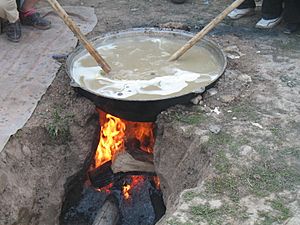Kazan (cookware) facts for kids

A kazan or qazan is a large cooking pot used in many parts of the world, especially in Central Asia, Azerbaijan, Turkey, and the Balkan Peninsula. Think of it like a giant cauldron or a big Dutch oven.
Kazans come in many different sizes. Some are small, like pots you might use at home, but many are very large. People often measure them by how much they can hold, like "a 50-litre kazan." A common kazan might be about half a meter (about 20 inches) wide.
These pots are usually made from cast iron, which is very strong and holds heat well. Nowadays, you can also find them made from aluminum. Kazans are used to cook many different kinds of food, such as plov (pilaf), sumalak, shorpa, and bawyrsaq. Because they can cook large amounts of food, kazans are very important for big celebrations and parties where many guests need to be fed.
You can cook with a kazan in a few ways. Sometimes, people hang them over a fire using a special metal stand called a sajayaq. For very large kazans, a hole might be dug in the ground. The kazan sits in this hole, and a fire is built underneath it. There's usually a small opening on the side of the hole to add wood and let air in. Smaller kazans can even be used on gas stoves with a special metal piece that holds the pot steady and helps the heat reach it.
What's in a Name?
The word kazan comes from an old Turkic word, kaz-, which meant "to hollow out" or "to carve." Over time, it changed to kazğan in Middle Turkic languages, meaning "big copper vessel." One of the oldest times the word was written down was in 1073 in a book called Dīwān Lughāt al-Turk.
A Look Back in Time
Kazans were likely first invented by Turkic nomads, who were people who traveled from place to place. These pots were their main way of cooking. Kazans look a bit like the Chinese wok or the Indian karahi, but they are shaped differently and don't have handles.
Before the Turkic people moved into the western steppes, other groups like the Scythians used different cooking pots. Their pots were often made of clay or bronze and had a more rounded, belly-like shape, unlike the bowl-like kazan. However, some people living near the Turkic groups started using kazans because they were so useful, especially for making pilaf (a rice dish) for big events like weddings.
In the Ottoman Empire, which was a powerful empire many years ago, the kazan was a special symbol for the janissary soldiers. If these soldiers were unhappy with their leaders, they would sometimes flip over their kazan. This action meant they were rebelling or having a big disagreement. This is why in Turkey, the phrase "Kazan devirmek" (to overturn the kazan) means to start a mutiny or rebellion. Kazans in Turkey today often have a flat bottom, which is common in the Middle East.
Cities Named After Kazans
You might find the word "kazan" in the names of some cities!
- Gazandjyk (also called Bereket) is a city in Turkmenistan. Its name means "small cauldron" or "pot-kin," because -jyk is a suffix that means "small."
- Kazan is the capital city of the Republic of Tatarstan in Russia.

